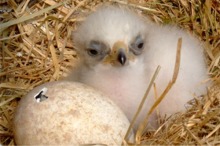|
|
Golden day for Donegal eagle
project
31.05.07
Donegal's national park
has become home to the first wild Golden Eagle chick
to hatch in Ireland in almost 100 years.
The location of its nest at Glenveagh National Park
is now being kept top secret to give the baby eagle
every chance of survival. Visitors to the park are being
asked not to try and seek out the eyrie. |
 |
Two chicks were
hatched, but as expected, the second chick died
after five days. The Golden Eagle Trust said there
would be a further wait of seven to eight weeks
before it was known whether the remaining chick
would thrive and fledge in late July.
Golden Eagles were last bred in Glenveagh in 1910
but became |
extinct in this country
after the last breeding attempt in Mayo in 1912.
Adult eagles were reintroduced into Glenveagh
National Park as part of a Golden Eagle
Reintroduction Programme in 2001. While eggs were
laid in 2005 and 2006, this is the first year that
young have been produced.
The breeding adults were collected as chicks from
the Highlands of Scotland. The pair was first
spotted together on August 1, 2006 and have been
together since.
Golden Eagles can live up to 30 years and usually
take four to six years to breed. They can produce
young for up to 20 years.
Project manager, Lorcán O Toole, from the Golden
Eagle Trust Ltd, said:
“Having a Golden Eagle eyrie with a chick in Ireland
was not unusual prior to the late 19th Century, as
they were a feature of our natural and cultural
heritage for millennia. This little chick is another
positive step in our ongoing work to see these
magnificent birds firmly re-established in Donegal
and down the west coast of Ireland."
He added: "Maybe it is another sign that we are
rediscovering our traditional respect for our
landscape. The eagle restoration project has been an
inclusive effort on the part of a large number of
people for over a decade now. But special thanks
must be paid to the hill sheep farmers and the wider
community in the hills of Donegal, who have
steadfastly supported the project.” |
|

